Case Study: Analyzing Tesco's Response to Declining Sales in the UK
VerifiedAdded on 2023/06/13
|57
|17099
|398
Case Study
AI Summary
This case study examines the declining sales of Tesco in the UK market, a significant issue for one of the largest retail brands. It explores the background of Tesco's success and the factors contributing to its recent performance decline, including the 2008 financial crisis, competition from smaller retailers, and underinvestment in the UK market. The study identifies problems within Tesco's HRM, finance, marketing, and operational management policies. It aims to determine the extent to which Tesco has addressed its declining sales and market share through strategic analysis using business models like SWOT and Value Chain analysis. The research methodology relies on secondary data to evaluate Tesco's performance post-reform and provides recommendations for future growth and stability. Desklib provides access to similar case studies and solved assignments.
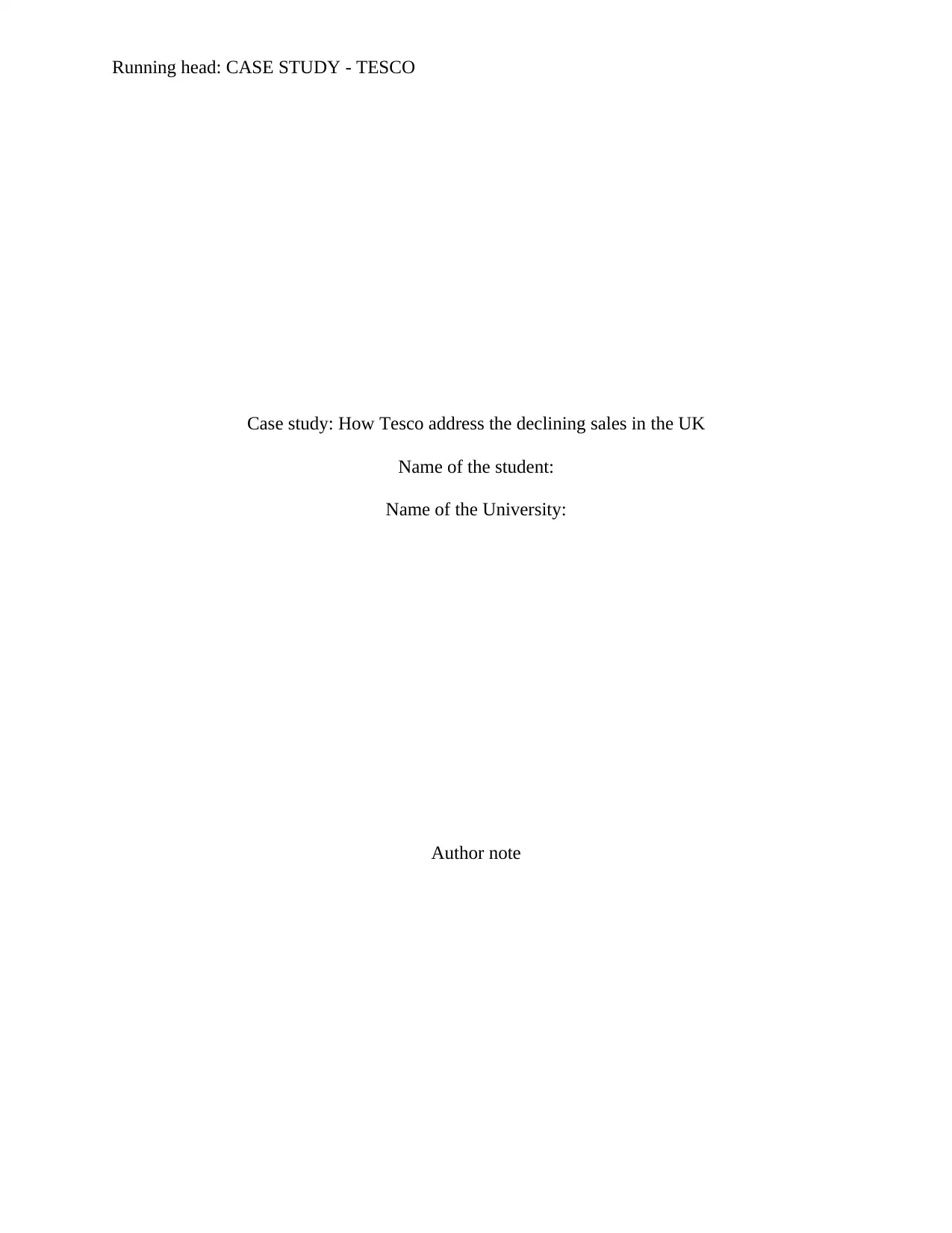
Running head: CASE STUDY - TESCO
Case study: How Tesco address the declining sales in the UK
Name of the student:
Name of the University:
Author note
Case study: How Tesco address the declining sales in the UK
Name of the student:
Name of the University:
Author note
Paraphrase This Document
Need a fresh take? Get an instant paraphrase of this document with our AI Paraphraser
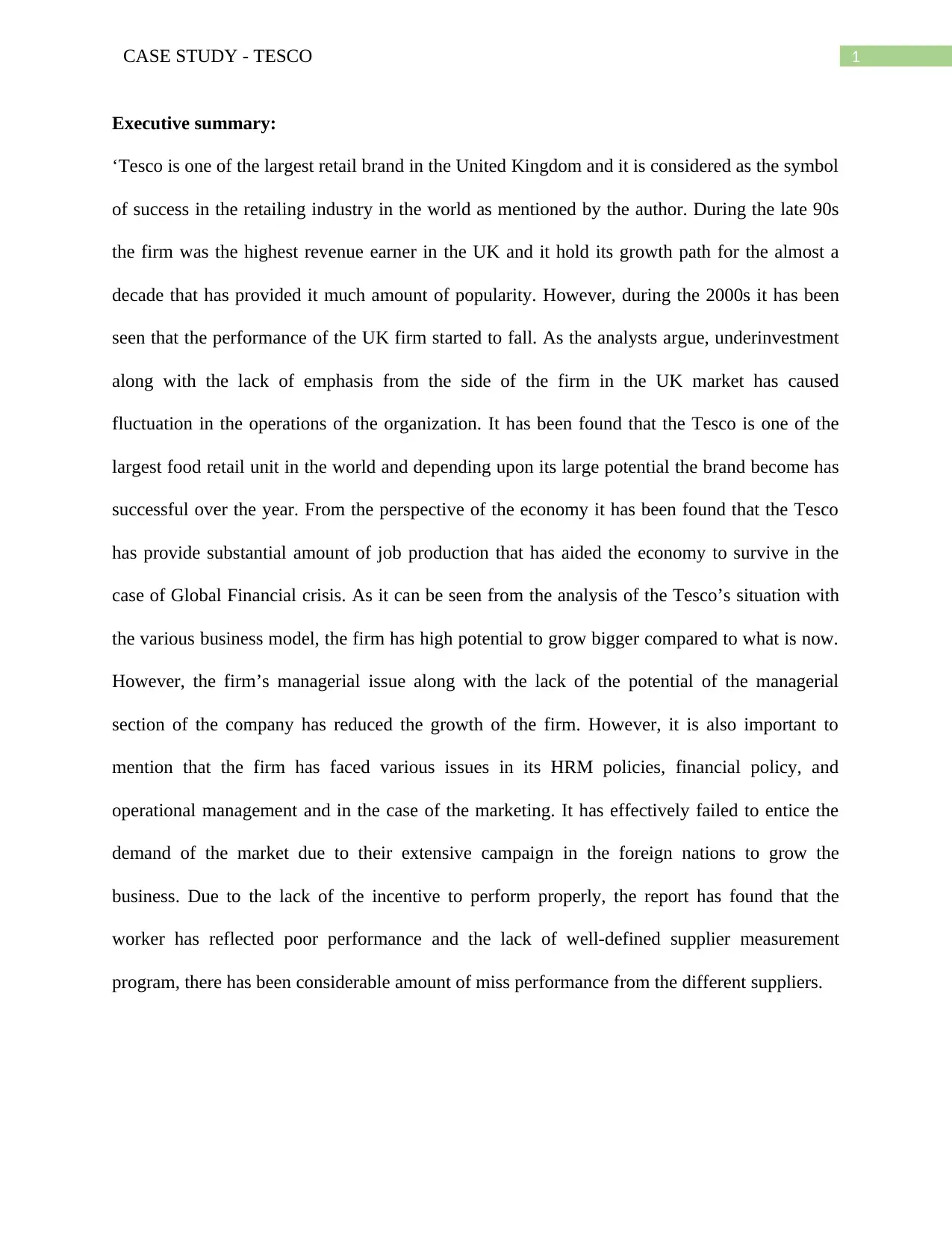
1CASE STUDY - TESCO
Executive summary:
‘Tesco is one of the largest retail brand in the United Kingdom and it is considered as the symbol
of success in the retailing industry in the world as mentioned by the author. During the late 90s
the firm was the highest revenue earner in the UK and it hold its growth path for the almost a
decade that has provided it much amount of popularity. However, during the 2000s it has been
seen that the performance of the UK firm started to fall. As the analysts argue, underinvestment
along with the lack of emphasis from the side of the firm in the UK market has caused
fluctuation in the operations of the organization. It has been found that the Tesco is one of the
largest food retail unit in the world and depending upon its large potential the brand become has
successful over the year. From the perspective of the economy it has been found that the Tesco
has provide substantial amount of job production that has aided the economy to survive in the
case of Global Financial crisis. As it can be seen from the analysis of the Tesco’s situation with
the various business model, the firm has high potential to grow bigger compared to what is now.
However, the firm’s managerial issue along with the lack of the potential of the managerial
section of the company has reduced the growth of the firm. However, it is also important to
mention that the firm has faced various issues in its HRM policies, financial policy, and
operational management and in the case of the marketing. It has effectively failed to entice the
demand of the market due to their extensive campaign in the foreign nations to grow the
business. Due to the lack of the incentive to perform properly, the report has found that the
worker has reflected poor performance and the lack of well-defined supplier measurement
program, there has been considerable amount of miss performance from the different suppliers.
Executive summary:
‘Tesco is one of the largest retail brand in the United Kingdom and it is considered as the symbol
of success in the retailing industry in the world as mentioned by the author. During the late 90s
the firm was the highest revenue earner in the UK and it hold its growth path for the almost a
decade that has provided it much amount of popularity. However, during the 2000s it has been
seen that the performance of the UK firm started to fall. As the analysts argue, underinvestment
along with the lack of emphasis from the side of the firm in the UK market has caused
fluctuation in the operations of the organization. It has been found that the Tesco is one of the
largest food retail unit in the world and depending upon its large potential the brand become has
successful over the year. From the perspective of the economy it has been found that the Tesco
has provide substantial amount of job production that has aided the economy to survive in the
case of Global Financial crisis. As it can be seen from the analysis of the Tesco’s situation with
the various business model, the firm has high potential to grow bigger compared to what is now.
However, the firm’s managerial issue along with the lack of the potential of the managerial
section of the company has reduced the growth of the firm. However, it is also important to
mention that the firm has faced various issues in its HRM policies, financial policy, and
operational management and in the case of the marketing. It has effectively failed to entice the
demand of the market due to their extensive campaign in the foreign nations to grow the
business. Due to the lack of the incentive to perform properly, the report has found that the
worker has reflected poor performance and the lack of well-defined supplier measurement
program, there has been considerable amount of miss performance from the different suppliers.
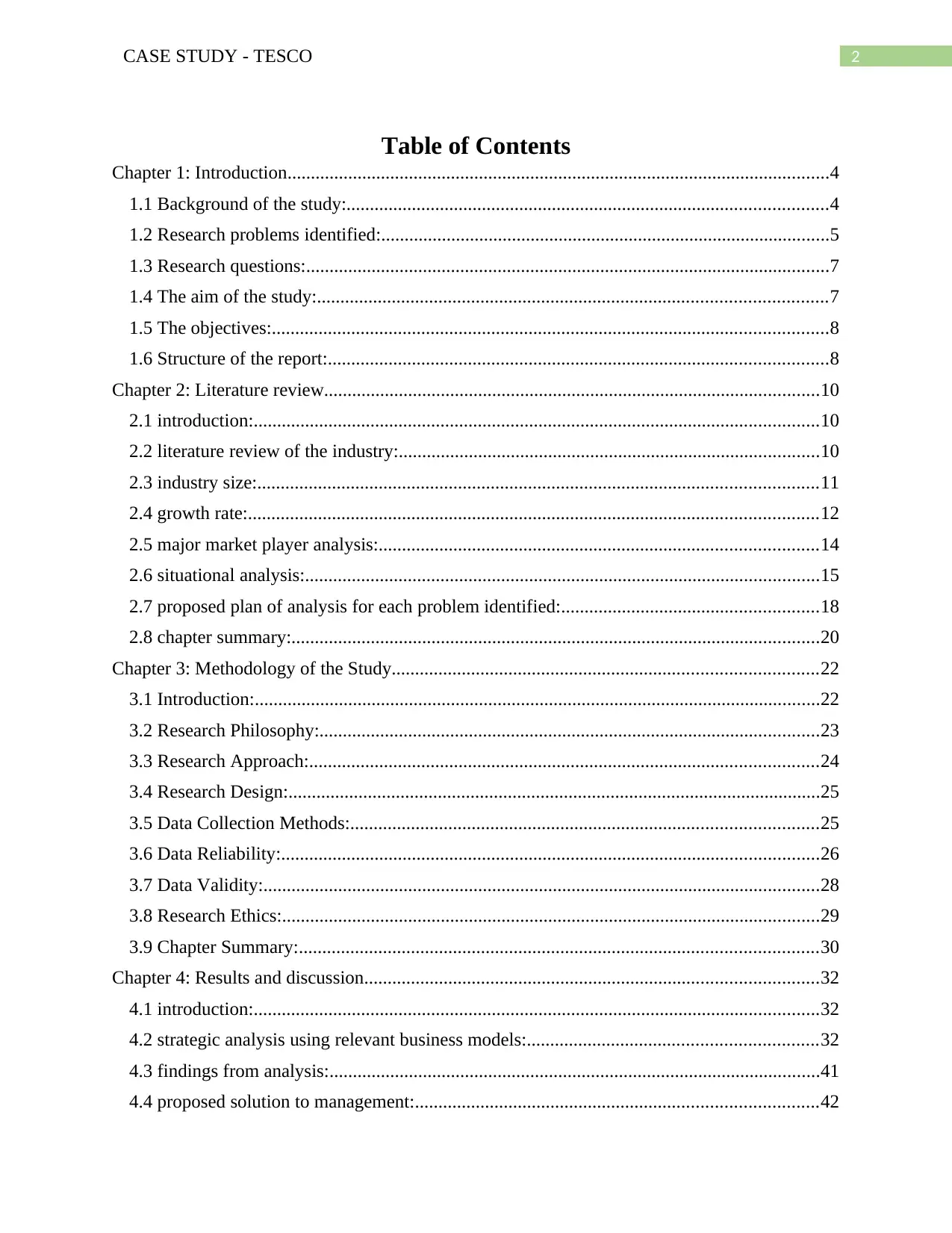
2CASE STUDY - TESCO
Table of Contents
Chapter 1: Introduction....................................................................................................................4
1.1 Background of the study:.......................................................................................................4
1.2 Research problems identified:................................................................................................5
1.3 Research questions:................................................................................................................7
1.4 The aim of the study:.............................................................................................................7
1.5 The objectives:.......................................................................................................................8
1.6 Structure of the report:...........................................................................................................8
Chapter 2: Literature review..........................................................................................................10
2.1 introduction:.........................................................................................................................10
2.2 literature review of the industry:..........................................................................................10
2.3 industry size:........................................................................................................................11
2.4 growth rate:..........................................................................................................................12
2.5 major market player analysis:..............................................................................................14
2.6 situational analysis:..............................................................................................................15
2.7 proposed plan of analysis for each problem identified:.......................................................18
2.8 chapter summary:.................................................................................................................20
Chapter 3: Methodology of the Study...........................................................................................22
3.1 Introduction:.........................................................................................................................22
3.2 Research Philosophy:...........................................................................................................23
3.3 Research Approach:.............................................................................................................24
3.4 Research Design:..................................................................................................................25
3.5 Data Collection Methods:....................................................................................................25
3.6 Data Reliability:...................................................................................................................26
3.7 Data Validity:.......................................................................................................................28
3.8 Research Ethics:...................................................................................................................29
3.9 Chapter Summary:...............................................................................................................30
Chapter 4: Results and discussion.................................................................................................32
4.1 introduction:.........................................................................................................................32
4.2 strategic analysis using relevant business models:..............................................................32
4.3 findings from analysis:.........................................................................................................41
4.4 proposed solution to management:......................................................................................42
Table of Contents
Chapter 1: Introduction....................................................................................................................4
1.1 Background of the study:.......................................................................................................4
1.2 Research problems identified:................................................................................................5
1.3 Research questions:................................................................................................................7
1.4 The aim of the study:.............................................................................................................7
1.5 The objectives:.......................................................................................................................8
1.6 Structure of the report:...........................................................................................................8
Chapter 2: Literature review..........................................................................................................10
2.1 introduction:.........................................................................................................................10
2.2 literature review of the industry:..........................................................................................10
2.3 industry size:........................................................................................................................11
2.4 growth rate:..........................................................................................................................12
2.5 major market player analysis:..............................................................................................14
2.6 situational analysis:..............................................................................................................15
2.7 proposed plan of analysis for each problem identified:.......................................................18
2.8 chapter summary:.................................................................................................................20
Chapter 3: Methodology of the Study...........................................................................................22
3.1 Introduction:.........................................................................................................................22
3.2 Research Philosophy:...........................................................................................................23
3.3 Research Approach:.............................................................................................................24
3.4 Research Design:..................................................................................................................25
3.5 Data Collection Methods:....................................................................................................25
3.6 Data Reliability:...................................................................................................................26
3.7 Data Validity:.......................................................................................................................28
3.8 Research Ethics:...................................................................................................................29
3.9 Chapter Summary:...............................................................................................................30
Chapter 4: Results and discussion.................................................................................................32
4.1 introduction:.........................................................................................................................32
4.2 strategic analysis using relevant business models:..............................................................32
4.3 findings from analysis:.........................................................................................................41
4.4 proposed solution to management:......................................................................................42
⊘ This is a preview!⊘
Do you want full access?
Subscribe today to unlock all pages.

Trusted by 1+ million students worldwide
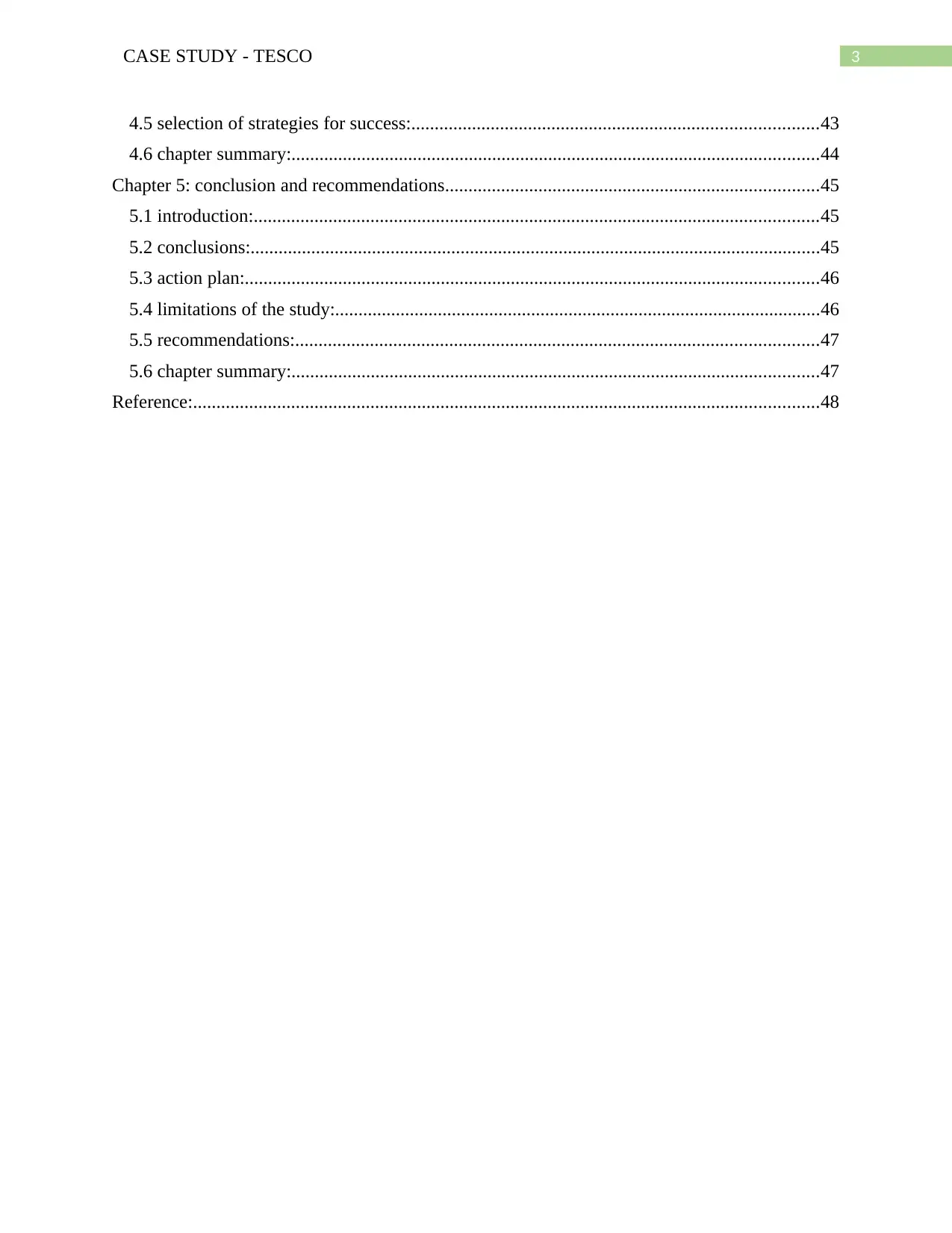
3CASE STUDY - TESCO
4.5 selection of strategies for success:.......................................................................................43
4.6 chapter summary:.................................................................................................................44
Chapter 5: conclusion and recommendations................................................................................45
5.1 introduction:.........................................................................................................................45
5.2 conclusions:..........................................................................................................................45
5.3 action plan:...........................................................................................................................46
5.4 limitations of the study:........................................................................................................46
5.5 recommendations:................................................................................................................47
5.6 chapter summary:.................................................................................................................47
Reference:......................................................................................................................................48
4.5 selection of strategies for success:.......................................................................................43
4.6 chapter summary:.................................................................................................................44
Chapter 5: conclusion and recommendations................................................................................45
5.1 introduction:.........................................................................................................................45
5.2 conclusions:..........................................................................................................................45
5.3 action plan:...........................................................................................................................46
5.4 limitations of the study:........................................................................................................46
5.5 recommendations:................................................................................................................47
5.6 chapter summary:.................................................................................................................47
Reference:......................................................................................................................................48
Paraphrase This Document
Need a fresh take? Get an instant paraphrase of this document with our AI Paraphraser
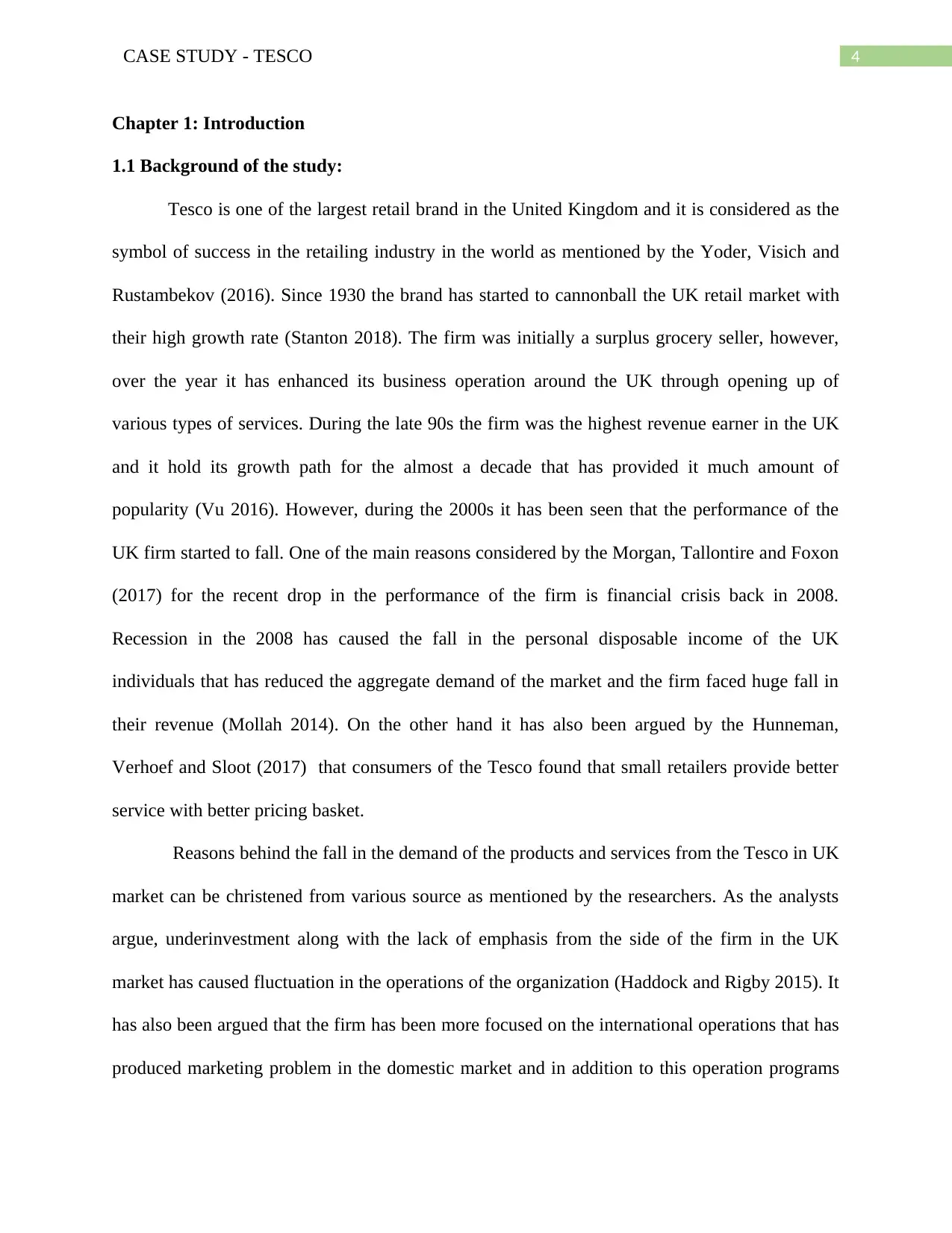
4CASE STUDY - TESCO
Chapter 1: Introduction
1.1 Background of the study:
Tesco is one of the largest retail brand in the United Kingdom and it is considered as the
symbol of success in the retailing industry in the world as mentioned by the Yoder, Visich and
Rustambekov (2016). Since 1930 the brand has started to cannonball the UK retail market with
their high growth rate (Stanton 2018). The firm was initially a surplus grocery seller, however,
over the year it has enhanced its business operation around the UK through opening up of
various types of services. During the late 90s the firm was the highest revenue earner in the UK
and it hold its growth path for the almost a decade that has provided it much amount of
popularity (Vu 2016). However, during the 2000s it has been seen that the performance of the
UK firm started to fall. One of the main reasons considered by the Morgan, Tallontire and Foxon
(2017) for the recent drop in the performance of the firm is financial crisis back in 2008.
Recession in the 2008 has caused the fall in the personal disposable income of the UK
individuals that has reduced the aggregate demand of the market and the firm faced huge fall in
their revenue (Mollah 2014). On the other hand it has also been argued by the Hunneman,
Verhoef and Sloot (2017) that consumers of the Tesco found that small retailers provide better
service with better pricing basket.
Reasons behind the fall in the demand of the products and services from the Tesco in UK
market can be christened from various source as mentioned by the researchers. As the analysts
argue, underinvestment along with the lack of emphasis from the side of the firm in the UK
market has caused fluctuation in the operations of the organization (Haddock and Rigby 2015). It
has also been argued that the firm has been more focused on the international operations that has
produced marketing problem in the domestic market and in addition to this operation programs
Chapter 1: Introduction
1.1 Background of the study:
Tesco is one of the largest retail brand in the United Kingdom and it is considered as the
symbol of success in the retailing industry in the world as mentioned by the Yoder, Visich and
Rustambekov (2016). Since 1930 the brand has started to cannonball the UK retail market with
their high growth rate (Stanton 2018). The firm was initially a surplus grocery seller, however,
over the year it has enhanced its business operation around the UK through opening up of
various types of services. During the late 90s the firm was the highest revenue earner in the UK
and it hold its growth path for the almost a decade that has provided it much amount of
popularity (Vu 2016). However, during the 2000s it has been seen that the performance of the
UK firm started to fall. One of the main reasons considered by the Morgan, Tallontire and Foxon
(2017) for the recent drop in the performance of the firm is financial crisis back in 2008.
Recession in the 2008 has caused the fall in the personal disposable income of the UK
individuals that has reduced the aggregate demand of the market and the firm faced huge fall in
their revenue (Mollah 2014). On the other hand it has also been argued by the Hunneman,
Verhoef and Sloot (2017) that consumers of the Tesco found that small retailers provide better
service with better pricing basket.
Reasons behind the fall in the demand of the products and services from the Tesco in UK
market can be christened from various source as mentioned by the researchers. As the analysts
argue, underinvestment along with the lack of emphasis from the side of the firm in the UK
market has caused fluctuation in the operations of the organization (Haddock and Rigby 2015). It
has also been argued that the firm has been more focused on the international operations that has
produced marketing problem in the domestic market and in addition to this operation programs
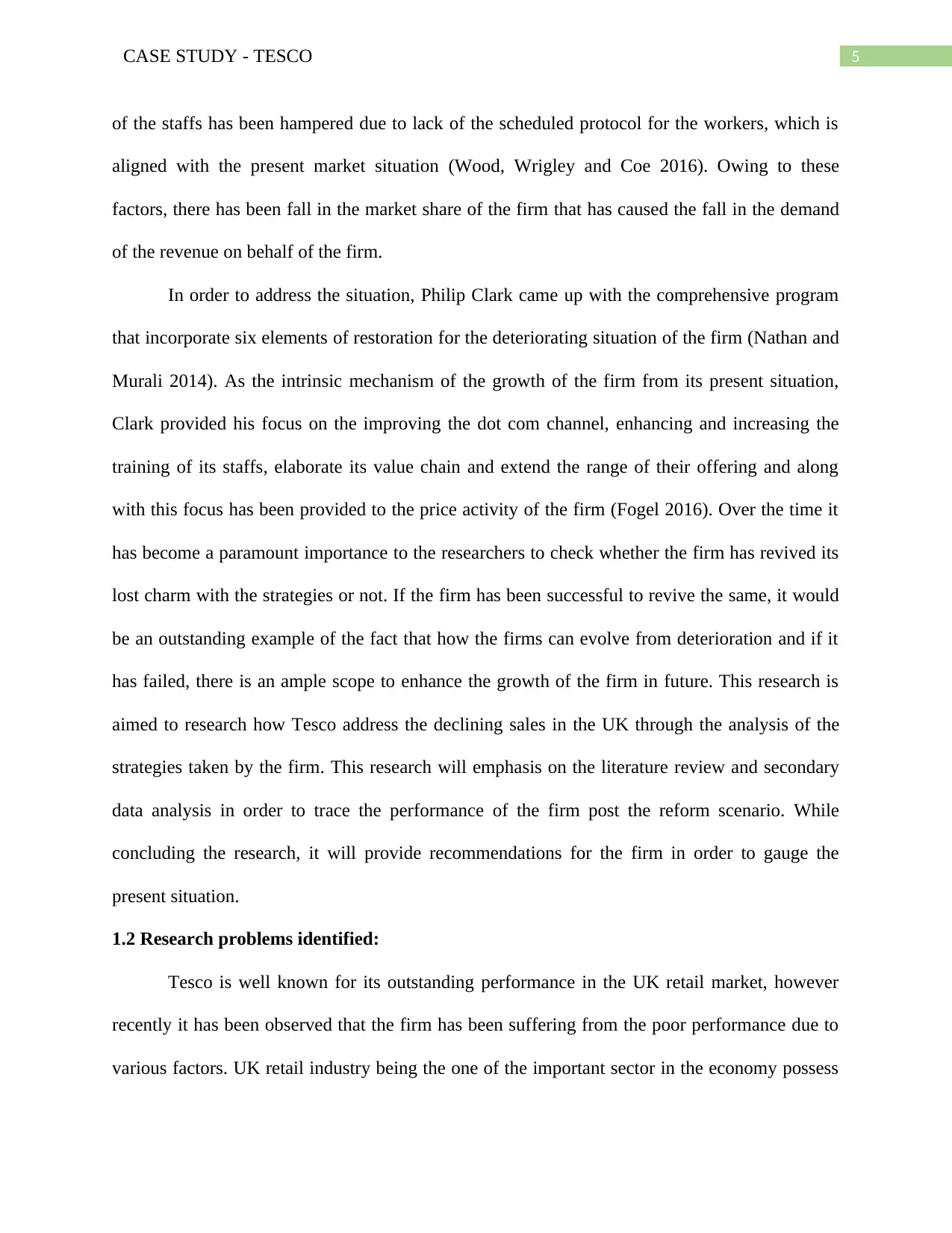
5CASE STUDY - TESCO
of the staffs has been hampered due to lack of the scheduled protocol for the workers, which is
aligned with the present market situation (Wood, Wrigley and Coe 2016). Owing to these
factors, there has been fall in the market share of the firm that has caused the fall in the demand
of the revenue on behalf of the firm.
In order to address the situation, Philip Clark came up with the comprehensive program
that incorporate six elements of restoration for the deteriorating situation of the firm (Nathan and
Murali 2014). As the intrinsic mechanism of the growth of the firm from its present situation,
Clark provided his focus on the improving the dot com channel, enhancing and increasing the
training of its staffs, elaborate its value chain and extend the range of their offering and along
with this focus has been provided to the price activity of the firm (Fogel 2016). Over the time it
has become a paramount importance to the researchers to check whether the firm has revived its
lost charm with the strategies or not. If the firm has been successful to revive the same, it would
be an outstanding example of the fact that how the firms can evolve from deterioration and if it
has failed, there is an ample scope to enhance the growth of the firm in future. This research is
aimed to research how Tesco address the declining sales in the UK through the analysis of the
strategies taken by the firm. This research will emphasis on the literature review and secondary
data analysis in order to trace the performance of the firm post the reform scenario. While
concluding the research, it will provide recommendations for the firm in order to gauge the
present situation.
1.2 Research problems identified:
Tesco is well known for its outstanding performance in the UK retail market, however
recently it has been observed that the firm has been suffering from the poor performance due to
various factors. UK retail industry being the one of the important sector in the economy possess
of the staffs has been hampered due to lack of the scheduled protocol for the workers, which is
aligned with the present market situation (Wood, Wrigley and Coe 2016). Owing to these
factors, there has been fall in the market share of the firm that has caused the fall in the demand
of the revenue on behalf of the firm.
In order to address the situation, Philip Clark came up with the comprehensive program
that incorporate six elements of restoration for the deteriorating situation of the firm (Nathan and
Murali 2014). As the intrinsic mechanism of the growth of the firm from its present situation,
Clark provided his focus on the improving the dot com channel, enhancing and increasing the
training of its staffs, elaborate its value chain and extend the range of their offering and along
with this focus has been provided to the price activity of the firm (Fogel 2016). Over the time it
has become a paramount importance to the researchers to check whether the firm has revived its
lost charm with the strategies or not. If the firm has been successful to revive the same, it would
be an outstanding example of the fact that how the firms can evolve from deterioration and if it
has failed, there is an ample scope to enhance the growth of the firm in future. This research is
aimed to research how Tesco address the declining sales in the UK through the analysis of the
strategies taken by the firm. This research will emphasis on the literature review and secondary
data analysis in order to trace the performance of the firm post the reform scenario. While
concluding the research, it will provide recommendations for the firm in order to gauge the
present situation.
1.2 Research problems identified:
Tesco is well known for its outstanding performance in the UK retail market, however
recently it has been observed that the firm has been suffering from the poor performance due to
various factors. UK retail industry being the one of the important sector in the economy possess
⊘ This is a preview!⊘
Do you want full access?
Subscribe today to unlock all pages.

Trusted by 1+ million students worldwide
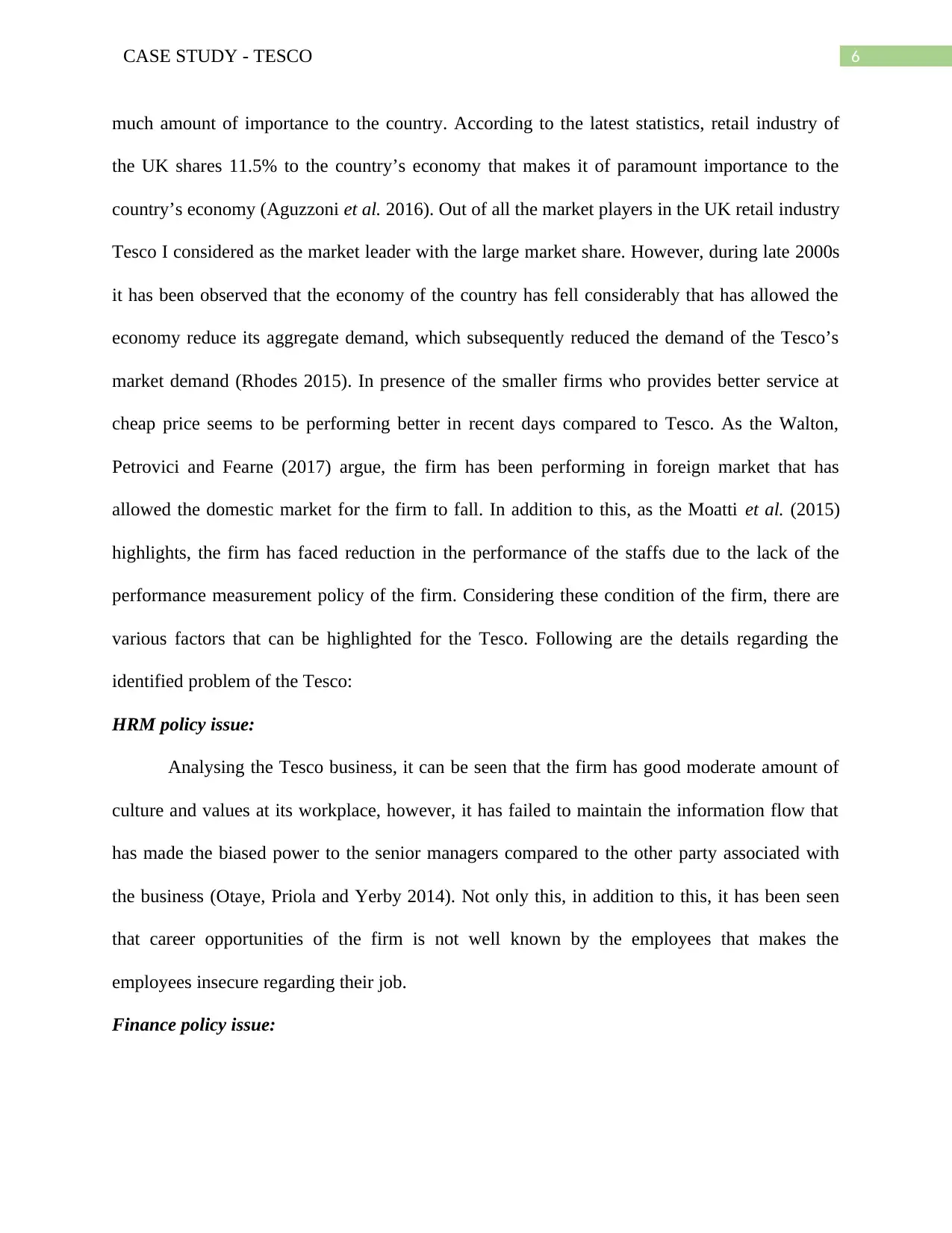
6CASE STUDY - TESCO
much amount of importance to the country. According to the latest statistics, retail industry of
the UK shares 11.5% to the country’s economy that makes it of paramount importance to the
country’s economy (Aguzzoni et al. 2016). Out of all the market players in the UK retail industry
Tesco I considered as the market leader with the large market share. However, during late 2000s
it has been observed that the economy of the country has fell considerably that has allowed the
economy reduce its aggregate demand, which subsequently reduced the demand of the Tesco’s
market demand (Rhodes 2015). In presence of the smaller firms who provides better service at
cheap price seems to be performing better in recent days compared to Tesco. As the Walton,
Petrovici and Fearne (2017) argue, the firm has been performing in foreign market that has
allowed the domestic market for the firm to fall. In addition to this, as the Moatti et al. (2015)
highlights, the firm has faced reduction in the performance of the staffs due to the lack of the
performance measurement policy of the firm. Considering these condition of the firm, there are
various factors that can be highlighted for the Tesco. Following are the details regarding the
identified problem of the Tesco:
HRM policy issue:
Analysing the Tesco business, it can be seen that the firm has good moderate amount of
culture and values at its workplace, however, it has failed to maintain the information flow that
has made the biased power to the senior managers compared to the other party associated with
the business (Otaye, Priola and Yerby 2014). Not only this, in addition to this, it has been seen
that career opportunities of the firm is not well known by the employees that makes the
employees insecure regarding their job.
Finance policy issue:
much amount of importance to the country. According to the latest statistics, retail industry of
the UK shares 11.5% to the country’s economy that makes it of paramount importance to the
country’s economy (Aguzzoni et al. 2016). Out of all the market players in the UK retail industry
Tesco I considered as the market leader with the large market share. However, during late 2000s
it has been observed that the economy of the country has fell considerably that has allowed the
economy reduce its aggregate demand, which subsequently reduced the demand of the Tesco’s
market demand (Rhodes 2015). In presence of the smaller firms who provides better service at
cheap price seems to be performing better in recent days compared to Tesco. As the Walton,
Petrovici and Fearne (2017) argue, the firm has been performing in foreign market that has
allowed the domestic market for the firm to fall. In addition to this, as the Moatti et al. (2015)
highlights, the firm has faced reduction in the performance of the staffs due to the lack of the
performance measurement policy of the firm. Considering these condition of the firm, there are
various factors that can be highlighted for the Tesco. Following are the details regarding the
identified problem of the Tesco:
HRM policy issue:
Analysing the Tesco business, it can be seen that the firm has good moderate amount of
culture and values at its workplace, however, it has failed to maintain the information flow that
has made the biased power to the senior managers compared to the other party associated with
the business (Otaye, Priola and Yerby 2014). Not only this, in addition to this, it has been seen
that career opportunities of the firm is not well known by the employees that makes the
employees insecure regarding their job.
Finance policy issue:
Paraphrase This Document
Need a fresh take? Get an instant paraphrase of this document with our AI Paraphraser
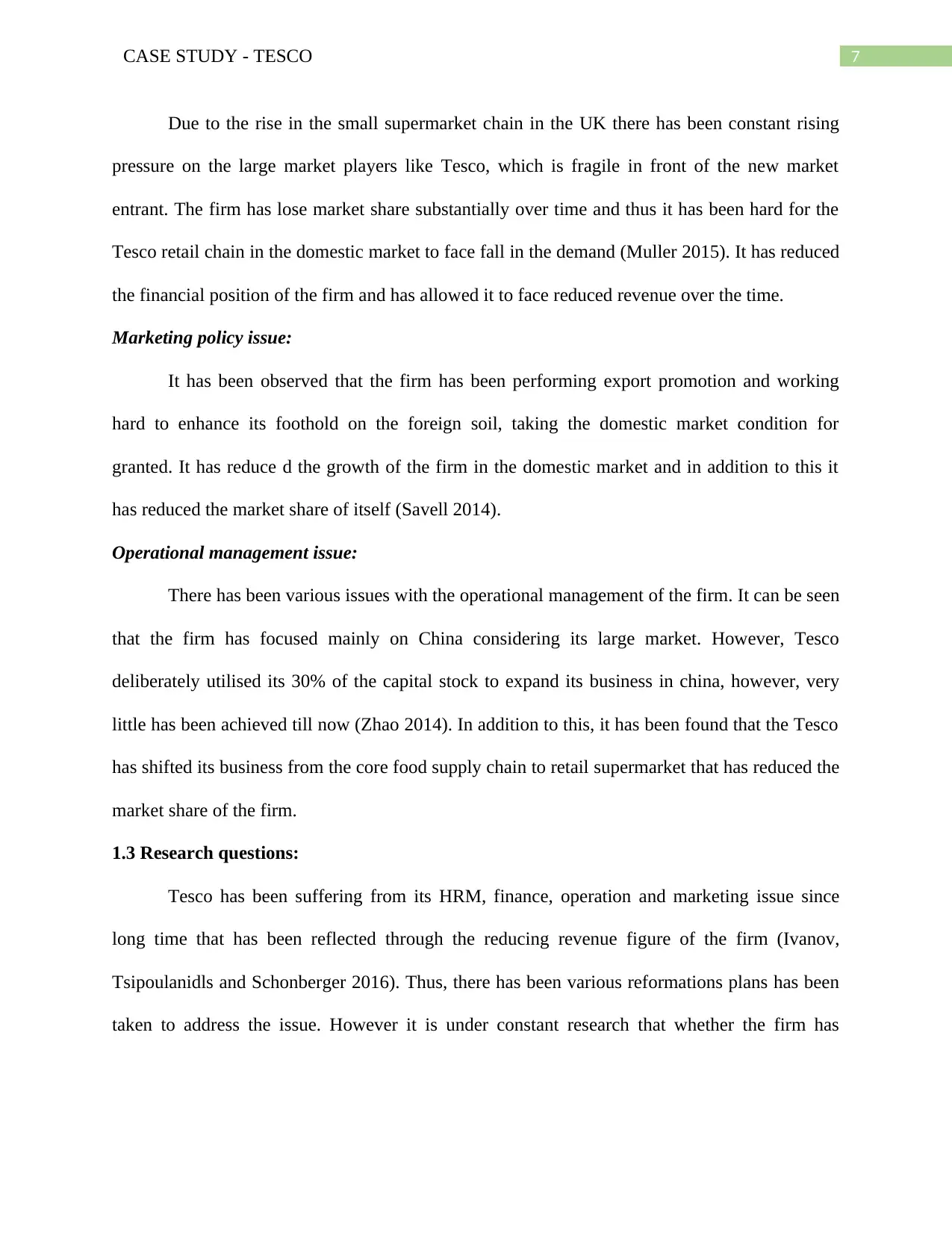
7CASE STUDY - TESCO
Due to the rise in the small supermarket chain in the UK there has been constant rising
pressure on the large market players like Tesco, which is fragile in front of the new market
entrant. The firm has lose market share substantially over time and thus it has been hard for the
Tesco retail chain in the domestic market to face fall in the demand (Muller 2015). It has reduced
the financial position of the firm and has allowed it to face reduced revenue over the time.
Marketing policy issue:
It has been observed that the firm has been performing export promotion and working
hard to enhance its foothold on the foreign soil, taking the domestic market condition for
granted. It has reduce d the growth of the firm in the domestic market and in addition to this it
has reduced the market share of itself (Savell 2014).
Operational management issue:
There has been various issues with the operational management of the firm. It can be seen
that the firm has focused mainly on China considering its large market. However, Tesco
deliberately utilised its 30% of the capital stock to expand its business in china, however, very
little has been achieved till now (Zhao 2014). In addition to this, it has been found that the Tesco
has shifted its business from the core food supply chain to retail supermarket that has reduced the
market share of the firm.
1.3 Research questions:
Tesco has been suffering from its HRM, finance, operation and marketing issue since
long time that has been reflected through the reducing revenue figure of the firm (Ivanov,
Tsipoulanidls and Schonberger 2016). Thus, there has been various reformations plans has been
taken to address the issue. However it is under constant research that whether the firm has
Due to the rise in the small supermarket chain in the UK there has been constant rising
pressure on the large market players like Tesco, which is fragile in front of the new market
entrant. The firm has lose market share substantially over time and thus it has been hard for the
Tesco retail chain in the domestic market to face fall in the demand (Muller 2015). It has reduced
the financial position of the firm and has allowed it to face reduced revenue over the time.
Marketing policy issue:
It has been observed that the firm has been performing export promotion and working
hard to enhance its foothold on the foreign soil, taking the domestic market condition for
granted. It has reduce d the growth of the firm in the domestic market and in addition to this it
has reduced the market share of itself (Savell 2014).
Operational management issue:
There has been various issues with the operational management of the firm. It can be seen
that the firm has focused mainly on China considering its large market. However, Tesco
deliberately utilised its 30% of the capital stock to expand its business in china, however, very
little has been achieved till now (Zhao 2014). In addition to this, it has been found that the Tesco
has shifted its business from the core food supply chain to retail supermarket that has reduced the
market share of the firm.
1.3 Research questions:
Tesco has been suffering from its HRM, finance, operation and marketing issue since
long time that has been reflected through the reducing revenue figure of the firm (Ivanov,
Tsipoulanidls and Schonberger 2016). Thus, there has been various reformations plans has been
taken to address the issue. However it is under constant research that whether the firm has
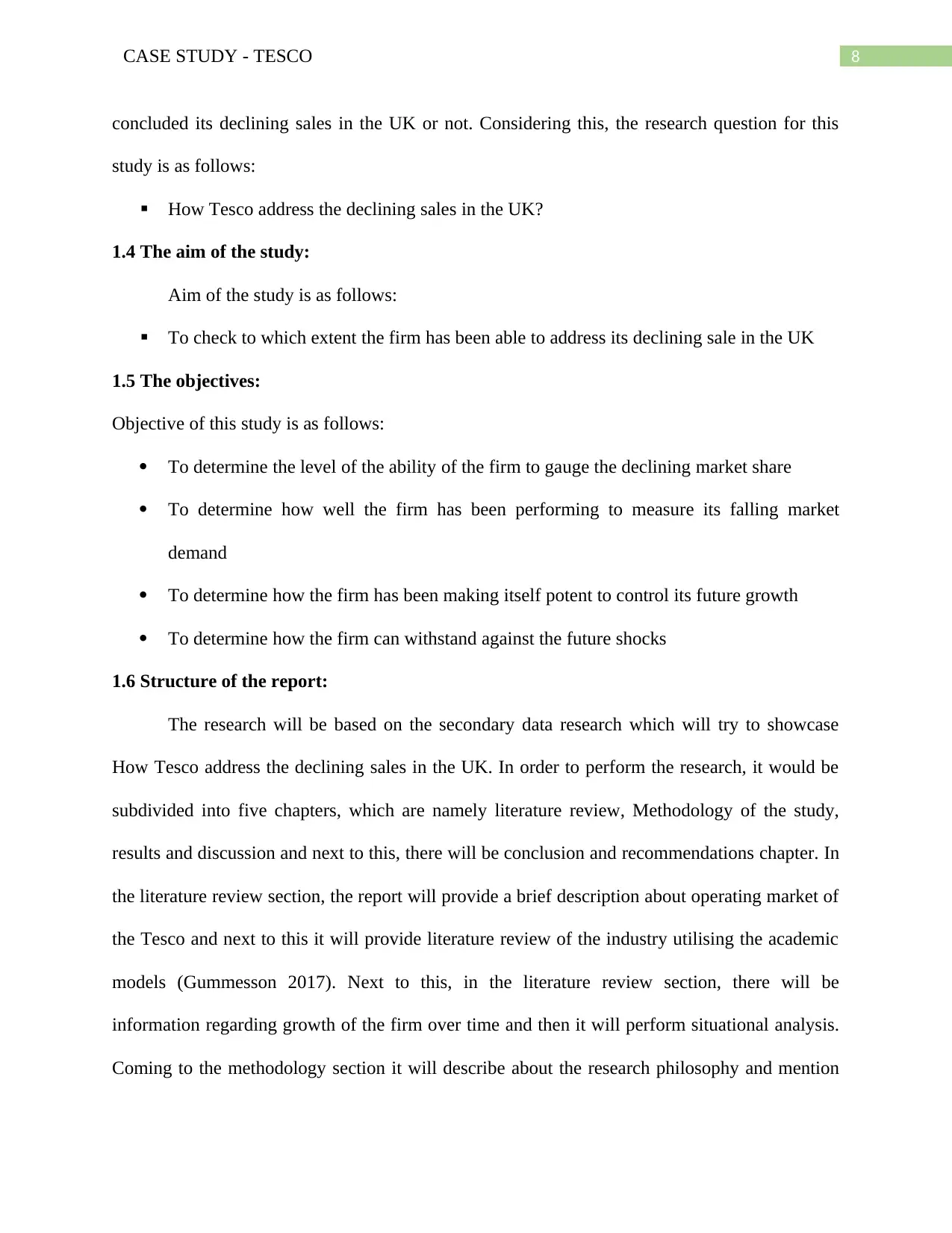
8CASE STUDY - TESCO
concluded its declining sales in the UK or not. Considering this, the research question for this
study is as follows:
How Tesco address the declining sales in the UK?
1.4 The aim of the study:
Aim of the study is as follows:
To check to which extent the firm has been able to address its declining sale in the UK
1.5 The objectives:
Objective of this study is as follows:
To determine the level of the ability of the firm to gauge the declining market share
To determine how well the firm has been performing to measure its falling market
demand
To determine how the firm has been making itself potent to control its future growth
To determine how the firm can withstand against the future shocks
1.6 Structure of the report:
The research will be based on the secondary data research which will try to showcase
How Tesco address the declining sales in the UK. In order to perform the research, it would be
subdivided into five chapters, which are namely literature review, Methodology of the study,
results and discussion and next to this, there will be conclusion and recommendations chapter. In
the literature review section, the report will provide a brief description about operating market of
the Tesco and next to this it will provide literature review of the industry utilising the academic
models (Gummesson 2017). Next to this, in the literature review section, there will be
information regarding growth of the firm over time and then it will perform situational analysis.
Coming to the methodology section it will describe about the research philosophy and mention
concluded its declining sales in the UK or not. Considering this, the research question for this
study is as follows:
How Tesco address the declining sales in the UK?
1.4 The aim of the study:
Aim of the study is as follows:
To check to which extent the firm has been able to address its declining sale in the UK
1.5 The objectives:
Objective of this study is as follows:
To determine the level of the ability of the firm to gauge the declining market share
To determine how well the firm has been performing to measure its falling market
demand
To determine how the firm has been making itself potent to control its future growth
To determine how the firm can withstand against the future shocks
1.6 Structure of the report:
The research will be based on the secondary data research which will try to showcase
How Tesco address the declining sales in the UK. In order to perform the research, it would be
subdivided into five chapters, which are namely literature review, Methodology of the study,
results and discussion and next to this, there will be conclusion and recommendations chapter. In
the literature review section, the report will provide a brief description about operating market of
the Tesco and next to this it will provide literature review of the industry utilising the academic
models (Gummesson 2017). Next to this, in the literature review section, there will be
information regarding growth of the firm over time and then it will perform situational analysis.
Coming to the methodology section it will describe about the research philosophy and mention
⊘ This is a preview!⊘
Do you want full access?
Subscribe today to unlock all pages.

Trusted by 1+ million students worldwide

9CASE STUDY - TESCO
the research approach. While doing so, it will portray the research design and highlight the data
collection methods. In order to verify the reliability of the same, it will perform data reliability
check and in the next portion of the third chapter, ethical consideration will be discussed. In the
fourth chapter, there will be discussion and result analysis, which will analyse the strategy of the
firm with the relevant business models like Swot, Value Chain, Porter’s Five Force model and
others (Hox, Moerbeek and Van 2017). Moving forward, in this section proposed solution to the
management will be provided and strategy selection will be performed. In the last chapter there
will be conclusion and recommendation section, which will portray the action plan and mention
the limitations of the study. In addition to thus, practical management recommendations those
are derived from the findings, will be provided and to conclude there will be a summarised
overview.
the research approach. While doing so, it will portray the research design and highlight the data
collection methods. In order to verify the reliability of the same, it will perform data reliability
check and in the next portion of the third chapter, ethical consideration will be discussed. In the
fourth chapter, there will be discussion and result analysis, which will analyse the strategy of the
firm with the relevant business models like Swot, Value Chain, Porter’s Five Force model and
others (Hox, Moerbeek and Van 2017). Moving forward, in this section proposed solution to the
management will be provided and strategy selection will be performed. In the last chapter there
will be conclusion and recommendation section, which will portray the action plan and mention
the limitations of the study. In addition to thus, practical management recommendations those
are derived from the findings, will be provided and to conclude there will be a summarised
overview.
Paraphrase This Document
Need a fresh take? Get an instant paraphrase of this document with our AI Paraphraser

10CASE STUDY - TESCO
Chapter 2: Literature review
2.1 introduction:
Tesco being one of the largest retail unit in the UK and the third largest in the world
possess much amount of importance to the economy. As it has been seen there has been rapid
growth in the firm’s performance over the time till 2000s it has shred substantially to the
country’s economy (Zokaei et al. 2016). In addition to this it has been seen that it is accounted
for the large amount of job creation for all thee skilled and semi-skilled labours it generates good
positivity to the economic growth to the economy. There has been substantial amount of research
regarding the performance of the Tesco over the time and it has been found that the firm has
performed well during the early 2000s, however, the market share of the firm felt sharply over
the time (Wood, Coe and Wrigley 2016). It has caused in the revenue of the firm and in addition
there has been substantial amount loss in the jobs too. This section of the research is aimed to
perform literature review considering the literal evidence from the previous researches. In this
section details regarding the market details of the Tesco will be analysed and in addition to this
situational analysis of the firm will be performed for the better understanding regarding the firm.
This section, in addition to the above, will mention the various proposed plan for addressing the
deteriorating revenue of the firm.
2.2 literature review of the industry:
UK retail industry is one of the largest sector of the economy that produces substantial
amount of job as well as shares substantially to the country’s economy. According to the
statistics, UK retail industry shares 11% to the total output of the economic output of the UK and
it is accounted for 10% job creation out of total employment opportunity in the nation (Rahman
2015). During 2015, there has been 2.8 million job creation in the UK retail industry and apart
Chapter 2: Literature review
2.1 introduction:
Tesco being one of the largest retail unit in the UK and the third largest in the world
possess much amount of importance to the economy. As it has been seen there has been rapid
growth in the firm’s performance over the time till 2000s it has shred substantially to the
country’s economy (Zokaei et al. 2016). In addition to this it has been seen that it is accounted
for the large amount of job creation for all thee skilled and semi-skilled labours it generates good
positivity to the economic growth to the economy. There has been substantial amount of research
regarding the performance of the Tesco over the time and it has been found that the firm has
performed well during the early 2000s, however, the market share of the firm felt sharply over
the time (Wood, Coe and Wrigley 2016). It has caused in the revenue of the firm and in addition
there has been substantial amount loss in the jobs too. This section of the research is aimed to
perform literature review considering the literal evidence from the previous researches. In this
section details regarding the market details of the Tesco will be analysed and in addition to this
situational analysis of the firm will be performed for the better understanding regarding the firm.
This section, in addition to the above, will mention the various proposed plan for addressing the
deteriorating revenue of the firm.
2.2 literature review of the industry:
UK retail industry is one of the largest sector of the economy that produces substantial
amount of job as well as shares substantially to the country’s economy. According to the
statistics, UK retail industry shares 11% to the total output of the economic output of the UK and
it is accounted for 10% job creation out of total employment opportunity in the nation (Rahman
2015). During 2015, there has been 2.8 million job creation in the UK retail industry and apart

11CASE STUDY - TESCO
from this, the industry has been popular for its rapid growth during last one decade (Adewuyi
2016). Details regarding the market structure of the economy has been mentioned below.
2.3 industry size:
UK retail industry is one of the largest and important sector of the economy, which had
been growing at a large rate during the recent past decades. However, over the year there has
been changing demand from the UK consumers from the supermarket retail industry that has
been causing fall in the rapid growth rate of the industry. One of the recent change can be
observed in the case of the Tesco as argued by the Amin and Broadbent (2015), which has faced
reduced demand since Global Financial Crisis of 2008.
Figure 1: UK retail industry growth
Source: (Aguzzoni et al. 2016)
Considering the figure 1, it can be seen that during last three years, there has been growth
in the UK retail sector compared to the previous years by 2.5% and it is expected to grow further
to the 5% level by the 2019 due to the ailing economic condition of the UK (Pantano 2014).
However, due to the fall in the reputation of the firm and presence of the smaller firms which can
provide better commodity basket with either at lower price or at same price is intimating the
customers to visit them. Besides this, according to the 2013 data, it has been seen that the four
from this, the industry has been popular for its rapid growth during last one decade (Adewuyi
2016). Details regarding the market structure of the economy has been mentioned below.
2.3 industry size:
UK retail industry is one of the largest and important sector of the economy, which had
been growing at a large rate during the recent past decades. However, over the year there has
been changing demand from the UK consumers from the supermarket retail industry that has
been causing fall in the rapid growth rate of the industry. One of the recent change can be
observed in the case of the Tesco as argued by the Amin and Broadbent (2015), which has faced
reduced demand since Global Financial Crisis of 2008.
Figure 1: UK retail industry growth
Source: (Aguzzoni et al. 2016)
Considering the figure 1, it can be seen that during last three years, there has been growth
in the UK retail sector compared to the previous years by 2.5% and it is expected to grow further
to the 5% level by the 2019 due to the ailing economic condition of the UK (Pantano 2014).
However, due to the fall in the reputation of the firm and presence of the smaller firms which can
provide better commodity basket with either at lower price or at same price is intimating the
customers to visit them. Besides this, according to the 2013 data, it has been seen that the four
⊘ This is a preview!⊘
Do you want full access?
Subscribe today to unlock all pages.

Trusted by 1+ million students worldwide
1 out of 57
Related Documents
Your All-in-One AI-Powered Toolkit for Academic Success.
+13062052269
info@desklib.com
Available 24*7 on WhatsApp / Email
![[object Object]](/_next/static/media/star-bottom.7253800d.svg)
Unlock your academic potential
Copyright © 2020–2025 A2Z Services. All Rights Reserved. Developed and managed by ZUCOL.





